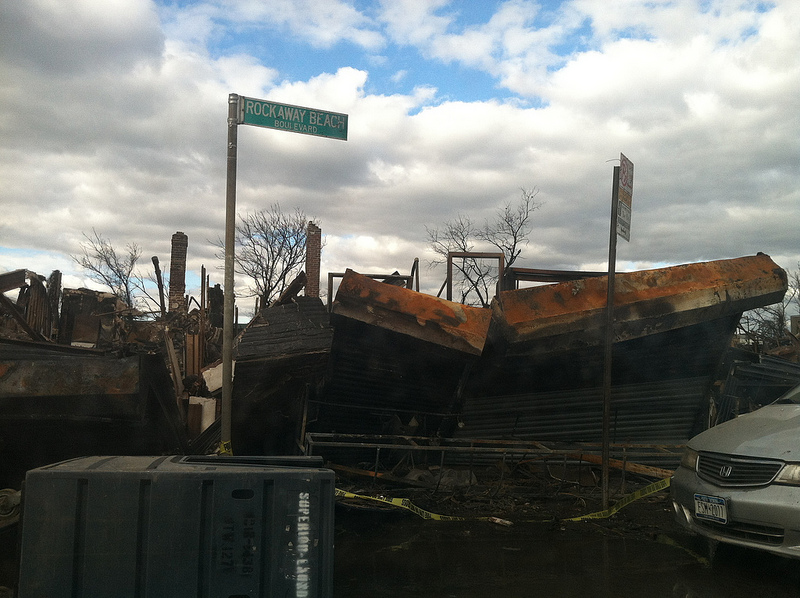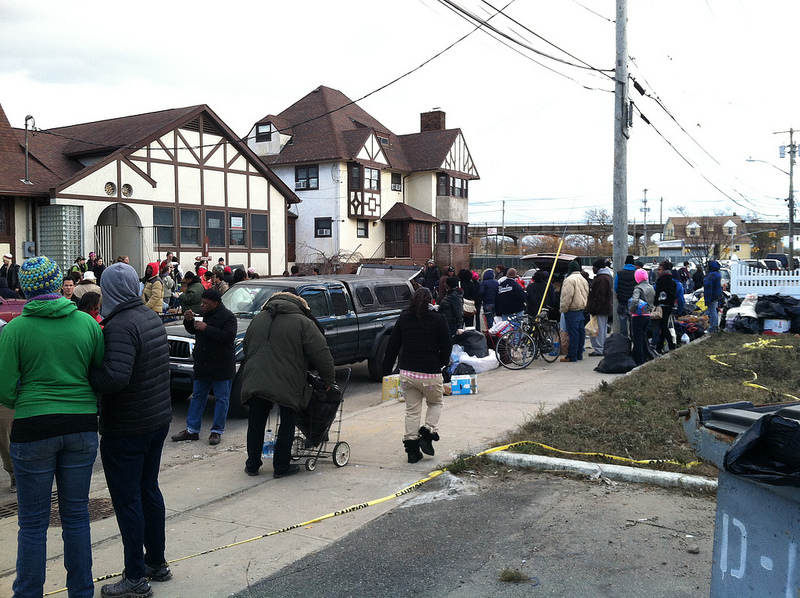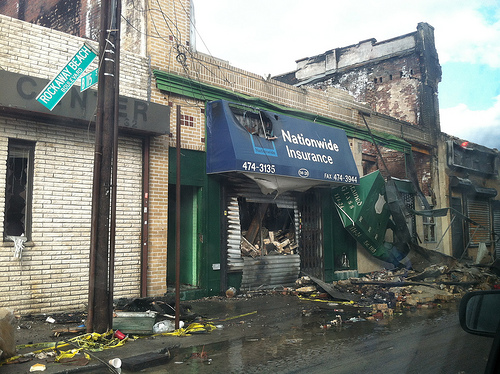by Marsha N.
November 10, 2012
I was able to visit Far Rockaway this past Monday, exactly a week after the hurricane hit that narrow sliver of land in Queens, off the Jamaica Bay.

As we drove into that community, via the Cross Bay Boulevard, just west of JFK, the stop lights were out and police were directing traffic. Once we had passed by a strip of stores and were getting into the residential area, piles of trash appeared, everywhere. We saw many people still busy clearing out their homes, with the dirty muddy water still dripping off their kids toys.
Cars lined up on the median had broken windows, weeds sticking out the exhaust. A medium-sized boat was blocking a lane, after clearly having been swept there. The medical student in the car explained that the trash needed to be removed as fast as it could because of the risk of mould and rats bearing disease.
Then we crossed the Cross Bay Bridge and entered an even more surreal zone. Rockaway Beach Boulevard runs parallel to the beach through Far Rockaway. There was sand everywhere and huge piles of wooden debris, from buildings and from the boardwalk, which had been flushed away.
There were dirty police cars right after we drove off the bridge and it felt like we were entering into a war zone. Small groups of people were clustered around a generator where they could charge cell phones. A few people were going through the hundreds of donated clothes that had been dumped right onto the dirty sandy ground, out in the open. Other people were lined up outside a food truck. And there was a mobile book truck outside a library.
What made the whole experience even more surreal is that most of the people I saw out on the street were middle-aged or elderly. Even though school is indefinitely canceled, I only saw one child.
Our first goal that day was to drop off a health care organizer and a medical student at a local church from where teams were being organized to canvas the tall residential apartment buildings for people stuck in their apartments.
About 55,000 people live in the Far Rockaway (for comparison, about 225,000 people lost power in Manhattan). The whole area is predominately working class and many first responders live in Far Rockaway. One important feature of that community is that it is considered a retirement community to some degree (as is Coney Island). There are many nursing homes, and I presume that there are also many elderly people living unassisted in the high rise buildings.

The canvassing was taking place to assess medical and other needs of the community members who chose or were unable to leave their homes. They would then send up teams later to drop off various necessities, such as batteries, water, clothing, basic medication, blankets and so forth.
We had also brought some donated supplies with us (thanks to the generosity of a Palestinian family who runs the grocery store on my street) and were able to unload those in the church’s hall, where the tables with loaded high with food and other necessities. It was still early and there weren’t many community members out, so it felt like the supplies we brought weren’t needed. Later in the day, when we returned, people were walking out of the hall with laundry carts loaded high; they were given a certain amount of time in the hall to take what they needed.
After dropping off the two canvassing volunteers, I drove to St John’s Episcopal Hospital, where myself and another organizer were going to check-in with our resident physician members. While St John’s Hospital sits a little higher up and so it hadn’t flooded, it has been without power since the hurricane hit. But because it wasn’t shut down and because many nursing homes evacuated their patients, St John’s Hospital has been running generators to power critical care portions of the hospital and all staff have been working tremendously long hours.
This is remarkable in and of itself because most staff were personally affected by the storm. They have lost their cars (which are useless due to the on-going gas shortage anyways), their homes and many belongings. Physicians are sleeping at the hospital, because they are working even longer hours than normal and because in some cases they have nowhere else to go, or can’t get to work for their shifts.
It seems like the generators and staff are running on fumes, literally. There is a high risk it could well close, at which point the patients would have to be moved again and hospital staff would face yet another serious disruption, to their paychecks and, for our members, to their training.

A few overall observations struck me that day:
We saw many sanitation trucks, although given the sheer magnitude of trash, it was far from sufficient. But besides those hard-working Teamsters, and besides police directing traffic, we didn’t see any local, state or federal workers.
It seems true that all relief, and I think this is true for Red Hook and Coney Island as well, is being provided through non-governmental organizations or small groups of individuals. This week we had a nor-easter hit and it dumped snow on the area and the temps dropped even further. Another mandatory evacuation was ordered for Far Rockaway, which means that the relief work that was being provided was suspended. People without transportation, food, heat and power were once again stranded. And the sanitation trucks were pulled to help clear the streets throughout the city.
Getting power back seems absolutely essential, but I really didn’t see many LIPA (the Long Island Power Authority) workers. Today I saw a statement by LIPA that they cannot restore power until the electrical systems have been approved, so that might explain their lack of visibility in the community.
That said, should something as essential as restoring power be left over to corporations without any oversight? How are they making decisions about staffing and also about where to concentrate their efforts? While billions are spent on homeland security, why are power providers not forced to retrofit their power stations to withstand flooding?
The same can be said about gas distribution: surely such an essential commodity would push the city to ensure that gas was supplied to those who needed it most, either for relief efforts, or for medical providers and so forth. We have now endured a week of gas shortages. Yesterday news was starting to emerge about violence at gas stations, so some police have been diverted to stand guard over long lines outside the few lucky gas stations. Only yesterday did the city finally make at least one smart decision, which is to organize refueling by allowing cars with license plates ending with an uneven number to fill up on uneven days and cars with license plates ending with an even number to fill up on even days.
Many criticisms about storm preparation and coordination have also emerged about the hospital system. How are they being accredited if components of their backup generators are vulnerable to flooding, even if their generators are better protected? We also heard that the hospital association, Greater NY, was still busy, a week after the storm, surveying the overall needs of the hospital system and how to best coordinate. Meanwhile where is the medical community in Far Rockaway? Or in Coney Island?
This past year NY State has put the hospital system in NYC under a microscope. Decisions are being made about which hospitals stay open and which are allowed to disappear. One of those was Peninsula Hospital, in Far Rockaway, which closed recently. It has been very hard for the community, and especially for those who live in underserved communities, to have their voices heard about the need for our safety-net hospitals to be supported. Instead it seems like the debate is about how to get private equity flowing into our non-profit hospitals. This hurricane amplifies the risks of that strategy.
Thankfully relief work at a small scale is happening—and the need for it became even more urgent when it was discovered, yesterday, that people who not evacuated from a whole bunch of city housing buildings in Coney Island, had not received any relief since Sandy hit. Even at that small scale it is far from insignificant. This work is assisting real people who were stuck with real needs that are, apartment by apartment, being met as best the volunteer relief teams can provide. But it will likely be too little and too late for some–they will lose jobs, will not be able to afford to fix their homes or pay their mortgages, their health outcomes will be negatively impacted, costing them and the already strained NYC health care system more, they will go into deeper debt to buy a new car, they will have to find individual solutions regarding childcare as long as the school system is crippled, and so forth.
Marsha is a member of Solidarity’s branch in New York City.
